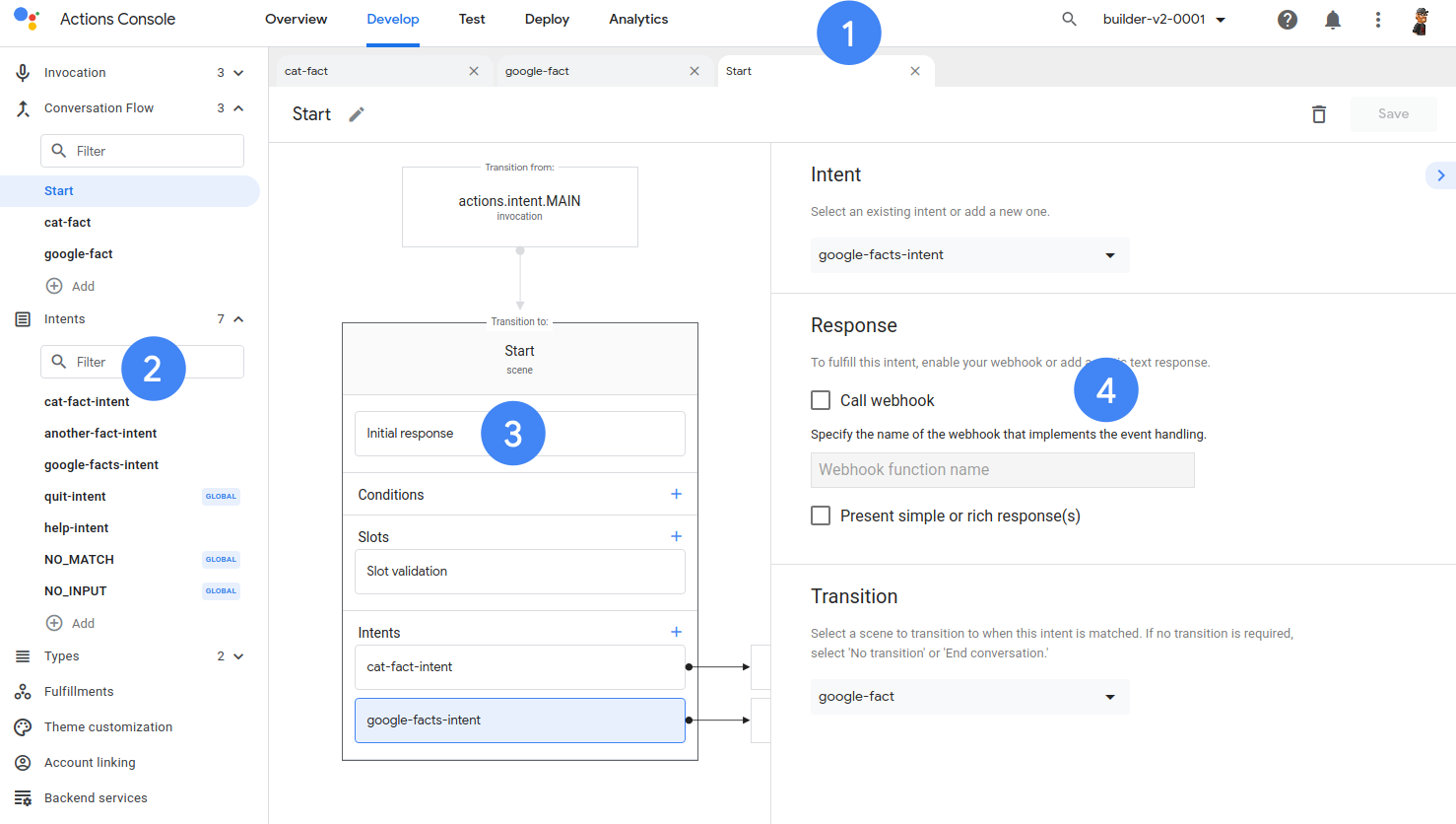Zum Erstellen von Conversational Actions müssen Sie die folgenden Komponenten erstellen und bereitstellen:
- Actions-Projekt: Der logische Container für alle Ihre Conversational Actions, Webservices und Web-Apps. Außerdem werden Projekteinstellungen und Ressourcen definiert, die beschreiben, wie Sie Ihr Projekt in Actions on Google bereitstellen.
- Aufrufmodell: Definiert, wie Nutzer die Actions in Ihrem Projekt finden und starten. Sie erstellen Ihr Aufrufmodell mit Intents und Typen.
- Unterhaltungsmodell: Definiert, was Nutzer zu Ihren Actions sagen können und wie Ihre Actions auf Nutzer reagieren. Sie erstellen Ihr konversationelles Modell mit Intents, Typen, Szenen und Prompts.
- Webhooks: Aktionen können Webhooks auslösen, um zusätzliche Logik an Ihre Fulfillment-Dienste zu delegieren, z. B. das Generieren von Prompts oder das Validieren von Daten.
- Interactive Canvas: Anstatt einfache Textantworten oder Rich Cards und Bilder zu senden, können Sie eine interaktive Web-App im Vollbildmodus bereitstellen, die auf HTML, CSS und JavaScript basiert.
In den folgenden Abschnitten werden die Tools beschrieben, die Sie zum Erstellen von Actions verwenden.
Aktionen
Die Actions API ist eine Reihe von Entwicklertools zum Erstellen von Aktionen für Google Assistant. Sie umfasst die folgenden Funktionen:
Eine offene, dateibasierte Darstellung eines Actions-Projekts: Erstellen Sie Ihre Aufruf- und Konversationsmodelle mit Intents, Typen, Szenen und Prompts. Sie können Ihre Actions-Projekte mit Ihrem bevorzugten Texteditor bearbeiten, sie in die Quellcodeverwaltung einchecken, automatisierte Prozesse erstellen und vieles mehr.
Befehlszeile: Das
gactions-Tool bietet eine Befehlszeile zum Bootstrapping und Automatisieren der Entwicklung Ihrer Actions. Damit können Sie Standard-Aktionsprojektdateien initialisieren, Updates in die Actions Console übertragen, Aktionsprojekte bereitstellen und vieles mehr. Mit dem Tool können Sie viele gängige Workflows ausführen, z. B. vorhandene Projekte importieren oder mit einem Feature-Branch in Ihrem bevorzugten Quellcodeverwaltungssystem arbeiten.Actions API: Die Actions API ist dieselbe API, die vom
gactions-Tool verwendet wird. Die Actions API bietet eine Liste von REST-Endpunkten zum Verwalten Ihrer Actions, einschließlich zum Testen und Erstellen. Mit der API können Sie viele gängige Arbeitsabläufe mit JSON-Anfragen ausführen. Bei der Verwendung der Actions API sind bestimmte Einschränkungen und Best Practices zu beachten.Webhooks und eine Node.js-Bibliothek für die Auftragsausführung: Mit Webhooks und einem JSON-basierten Messaging-Format können Ihre Aktionen Geschäftslogik an Ihre Webdienste delegieren. Wir stellen eine Node.js-Bibliothek zur Auftragsausführung zur Verfügung, die idiomatische Schnittstellen für den Unterhaltungs-Webhook bietet. Mit dieser Bibliothek lassen sich viele gängige Nutzerabläufe einfach implementieren. Einige Funktionen umfassen beispielsweise das Extrahieren von Parametern aus einer Nutzeranfrage und das Generieren einer multimodalen Erfahrung (nur Sprache und Sprache und Bilder) für Google Assistant.
Actions Builder
Actions Builder ist eine leistungsstarke und benutzerfreundliche webbasierte IDE, die in die Actions Console integriert ist. Da Actions Builder auf denselben Technologien wie die Actions API basiert, können Sie es je nach Bedarf allein oder zusammen mit der Actions API verwenden.

Die Actions Builder-Benutzeroberfläche ist in die folgenden Bereiche unterteilt:
- Über das obere Menü können Sie auf die verschiedenen Bereiche der Actions Console zugreifen. Actions Builder finden Sie auf dem Tab Develop (Entwickeln).
- Über das linke Menü können Sie auf alle Komponenten zugreifen, die zum Erstellen von Actions erforderlich sind, z. B. Intents und Szenen.
- Im Build-Bereich können Sie die Komponente erstellen, an der Sie gerade arbeiten.
- Im Detailbereich können Sie weitere Details zur Komponente konfigurieren, an der Sie gerade arbeiten.

